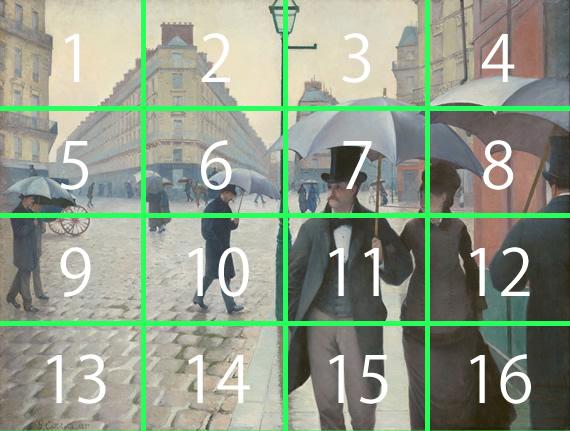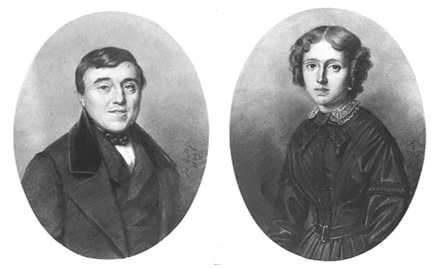
最新の記事
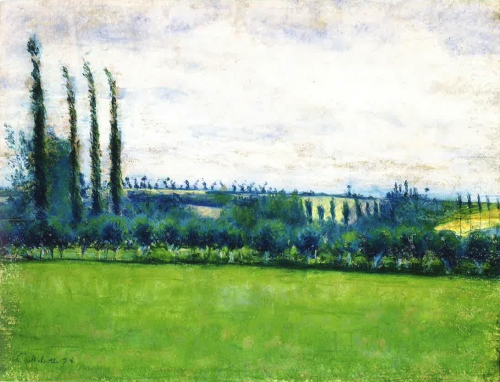 ブリヂストン美術館がカイユボットの《イエールの平原》を新所蔵&展示
ブリヂストン美術館がカイユボットの《イエールの平原》を新所蔵&展示
ランダム表示
- 2015年2月 (2)
- 2014年12月 (4)
- 2014年11月 (2)
- 2014年5月 (2)
- 2014年3月 (1)
- 2013年12月 (3)
- 2013年11月 (1)
- 2013年10月 (1)
- 2013年8月 (2)
- 2013年3月 (3)
- 2013年2月 (2)
- 2013年1月 (3)
- 2012年9月 (3)
- 2012年4月 (1)
- 2012年2月 (2)
- 2011年10月 (4)
- 2011年9月 (5)
- 2011年8月 (5)
- 2011年7月 (8)
- 2011年4月 (2)
- 2011年2月 (1)
- 2010年12月 (2)
- 2010年10月 (3)
- 2010年9月 (4)
- 2010年8月 (2)
- 2010年7月 (5)
- 2010年6月 (6)
- 2009年11月 (1)
- 2009年6月 (30)
- 2009年3月 (1)
- 2009年2月 (4)
- 2009年1月 (6)
- 2008年12月 (6)
- 2008年11月 (6)
- 2008年10月 (12)
- 2008年9月 (1)
- 2008年7月 (1)
- 2008年6月 (11)
- 2008年5月 (3)
- 2008年3月 (9)
- 2008年2月 (2)
- 2008年1月 (8)
- 2007年12月 (1)
- 2007年11月 (4)
- 2007年9月 (9)

サザビーズの「モンソー公園」訳
以前にクリスティーズで売りに出されていた「牡蠣の静物画」についての翻訳をお届けしましたが
先日サザビーズでも「モンソー公園」のオークションがあったようなのでまた翻訳してみました。
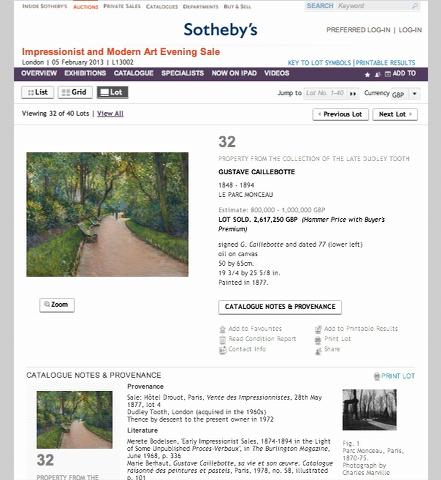
過去に取り扱われた作品もそれなりにあるし、また読んでみなくっちゃ!!
サザビーズの元ページはこちら >>
翻訳中の「図」については元ページをご覧下さい。
それではレッツ!
【由来】
パリ、オテル・デュルオの1877年5月28日の印象派作品売却にて。ロットナンバー4。
ロンドンのDudley Toothが1960年代に購入。
1972年現在の所有者に渡る。
落札予想価格:?800,000 – ?1,000,000 (7千万円〜1億4000万円)
販売価格:?2,617,250(3億6千万円)
〜中略(文献)〜
【作品について】
この作品は、ミロメニル通りのカイユボットの家にほど近い、パリ8区にあるモンソー公園(図2)を描いたとされるたった2枚の作品のうちの1枚だ。
こちらの作品ではカイユボットは、短く素早い筆致を使うことで青々とした下草を表現し、低木やベンチの周りの光と影の動きを研究し、明るい春の日の公園を描いた。
モンソー公園はオルレアン公の命令によって18世紀後半の英国庭園の様式で設計された公園だ。
元々は個人の私庭だったがオスマン男爵の下の公の公園に変わり、1861年に市民に一般公開された。
ロンドン王立美術館の大回顧展によって「都会の印象派」と名付けられたカイユボットは「公園」に自然と都会への愛好を結びつけるような素晴らしい主題を見いだしたのだ。
ジュリア・サグレイヴスはカイユボットとモネ(図3)の両作品についてこのように書いている。
「カイユボットとその友人モネは同時期にサン・ラザール駅周辺を描き、発表した。二人は、”市民公園\\\\”とりわけモンソー公園というサン・ラザール駅とはまた全く違う種類の近代都市風景への関心を共有しているようにも見える。この公園はカイユボットが1870年代を主に過ごした家からほど近くにあり、元々は18世紀に私的な一風変わった庭として設計されたものだ。フランス革命の間には政府の所有物だと宣言されたのだが、全体的に荒廃し使われなくなりながら約10年間個人の所有で有り続けた。第二帝政の間に政府がそれをきちんと取り戻し修復をして、モンソー公園は”パリのもっとも魅力的な散歩道のひとつ”になったのである。(J. Sagraves in Gustave Caillebotte: The Unknown Impressionist (exhibition catalogue), op. cit., p. 81)」
1870年代を通して、カイユボットとモネはしばしば似たような主題、特にパリとそれを取り巻くものを描いた。
実家が裕福であったカイユボットはこの間モネに経済的援助をし、またいくつかのモネの作品を購入し、コレクションしていった。
ジュリアはこの作品について「筆遣いや構図はモネを思い起こさせる。しかしカイユボットの描写は、モネが描いた公園の光景というよりも、当時カイユボットが所有していた”アパートの室内(図4)”に似ている。両作品には広く平坦な通路(公園の歩道・床)、前面への急な傾斜、作品の中央の断ち落としが見られる。また両作品の通路の終わりには孤独で、妙に小さく、ぼんやりとした人物が植物に覆われ、ほぼ埋められるように立っている。カイユボットはこのようにモンソー公園を描くことで、家の近くにある公園と快適でもあり不吉な感じでもあるプライベートな内面空間をなぞらえたのだ。 (ibid., p. 81)」と述べている。
ファッショナブルな衣服をまとった男女や子供のいるモンソー公園の社会的な側面を描いた(図3)モネと違って、カイユボットは緩やかなカーブの歩道を中心に置きその上に覆うように青々とした下草を描くことで、殆ど内面の幻影であるかのような公園のより孤独な面を表現した。
植物や木々が慎重に描かれていると同時に、こちらに向かって歩いてくる小さな男性の人影を圧倒し、構図を支配している。
大ざっぱで数少ない筆で描かれているが、男性はグレーのスーツと帽子をかぶったパリ紳士と分かる。
さらに、注意深く配置された低木や芝小道や規則正しく配置されたベンチは、都市の雰囲気を醸しだし、同時に力強くダイナミックな構図を作り出している。
Sale: Hôtel Drouot, Paris, Vente des Impressionnistes, 28th May 1877, lot 4
Dudley Tooth, London (acquired in the 1960s)
Thence by descent to the present owner in 1972
【Literature】
Merete Bodelsen, ‘Early Impressionist Sales, 1874-1894 in the Light of Some Unpublished Procès-Verbaux’, in The Burlington Magazine, June 1968, p. 336
Marie Berhaut, Gustave Caillebotte, sa vie et son œuvre. Catalogue raisonné des peintures et pastels, Paris, 1978, no. 58, illustrated p. 101
Pierre Wittmer, Caillebotte au jardin. La Période d’Yerres (1860-1879), Saint-Rémy-en-l’Eau, 1990, p. 242
Marie Berhaut, Gustave Caillebotte. Catalogue raisonné des peintures et pastels, Paris, 1994, no. 64, illustrated p. 97
Gustave Caillebotte: The Unknown Impressionist (exhibition catalogue), Galeries Nationales du Grand Palais, Paris; The Art Institute of Chicago & Los Angeles County Museum of Art, Los Angeles, 1994-95, illustrated p. 151 (in Paris); p. 81 (in Chicago)
【Catalogue Note】
The present work is one of only two known paintings that Caillebotte executed on the subject of Parc Monceau (fig. 2), a public garden located near the artist’s home on rue de Miromesnil, in the eighth arrondissement of Paris. In the present version, Caillebotte has depicted the park on a bright spring day, using short, quick brushstrokes to render its lush undergrowth and to explore the play of light and shadow on the shrubs and around the benches. Commissioned by the Duke of Orléans, Parc Monceau was designed in the style of the English garden in the second half of the eighteenth century. Originally a private garden, it was converted into a public park under Baron Haussmann, and opened to the public in 1861. Caillebotte, labelled by a major retrospective exhibition at the Royal Academy of Arts in London as the ‘urban Impressionist’, found in the park a great subject to paint, as it combined his love of nature with that of the city.
Julia Sagraves wrote about this subject-matter in the work of both Caillebotte and Monet (fig. 3): ‘At the same time that they were painting and exhibiting pictures of the area around Gare Saint-Lazare, Caillebotte and his friend Monet appear also to have shared an interest in another very different kind of urban space: the public city garden, and, in particular, Parc Monceau. The park was located only blocks away from where Caillebotte lived throughout most of the 1870s. It was originally laid out in the eighteenth century as a private, picturesque garden. During the French Revolution, it was declared the property of the State, but in the ensuing decades it continued to pass in and out of private ownership, while also falling into general disrepair and disuse. It was only during the Second Empire, when the State firmly reclaimed and restored it, that Parc Monceau became “one of the most agreeable promenades in Paris”’ (J. Sagraves in Gustave Caillebotte: The Unknown Impressionist (exhibition catalogue), op. cit., p. 81).
Throughout the 1870s, Caillebotte and Monet often chose to paint similar subjects, particularly views of Paris and its environs. Caillebotte, whose family belonged to the affluent grande bourgeoisie, also provided financial support to Monet during this time, and acquired several of Monet’s paintings for his collection. Writing about the present work, Julia Sagraves observed that it ‘recalls Monet in both its brushwork and composition. However, Caillebotte’s image resembles not so much Monet’s own views of the park, but instead his Apartment Interior [fig. 4], which Caillebotte owned at the time. In both works, a wide, smooth passageway (garden path, floor), tipped dramatically forward, cuts through the centre of the picture. At the end of this corridor stands a solitary, strangely diminished, indistinct figure, encased and nearly overwhelmed by the surrounding plant life. In depicting Parc Monceau in this manner, Caillebotte likened the space of his neighbourhood garden to private interior space, at once comforting and menacing’ (ibid., p. 81).
Unlike Monet, whose depictions of the Parc Monceau focused on its social aspect, with groups of fashionably dressed men, women and children (fig. 3), Caillebotte chose to represent a more solitary vision of the park, centred around the gently curving line of the path, and the lush greenery that closes above it, almost creating the illusion of an interior space. While the plants and trees appear to be carefully designed, their wild growth dominates the composition, towering over the small figure of a man who walks down the path towards the viewer. Although executed in a few sketchy brushstrokes, the man, wearing a grey suit and a hat, can be identified as a Parisian gentleman. Furthermore, the meticulously aligned shrubs and grass alleys and the rhythmically spaced benches give the scene its air of urban environment, while at the same time creating a vibrant, dynamic composition.
(quoted from Sotheby’s)
ブリヂストン美術館のカイユボット展に来ていたら個人的に嬉しい「10点」選んでみました
来るべきブリヂストン美術館のカイユボット展に何が来ていたら個人的に嬉しいか考えてみました!
(嬉しいか、というだけで予想ではありません。・・・暇なんですね^^;;)
まずこの三点はカイユボットの代表作として殿堂入り!
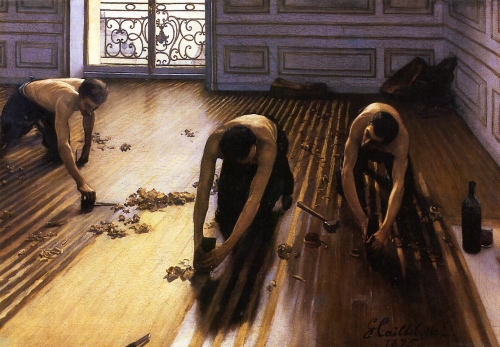
「床の鉋かけ」

「ヨーロッパ橋」
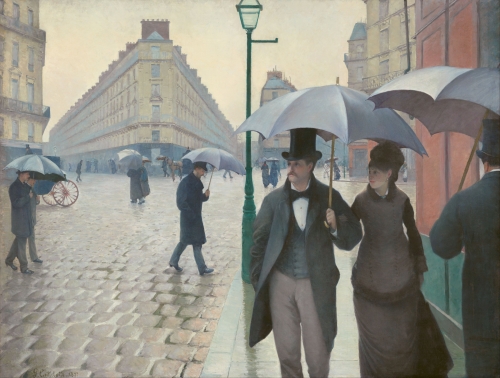
「パリの通り、雨(パリの街、雨)」
ここからは、色々迷って残り7点絞りました!!(順不同)
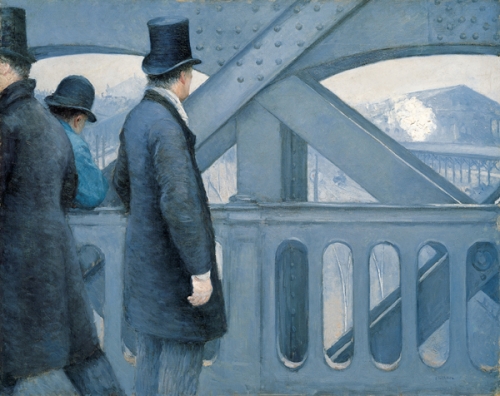
「ヨーロッパ橋 (別バージョン) 」
この色味、そしてこの構図!
作品の大部分を占める大胆な鉄骨、その隙間から見えるサン・ラザール駅の汽車と噴き出す蒸気。
それを眺める男たち、足早に過ぎる男。そしてそれをばっさりと切るカイユボットの思い切り!
いつ見ても惚れ惚れするわー。
なぜ印象派展に出展しなかったのだろう??
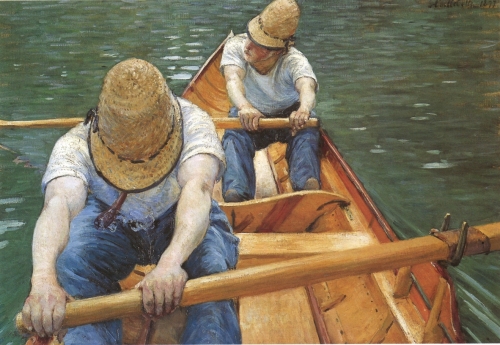
「オースマン」
水平線の映っていない川、顔のない男達。
この構図もなかなかできる事じゃないと思います。
こうして画像を見ている時と、実際本物の作品を見る時とでは自分の立ち位置(目線がどこにあるか)が違う事って多いので、この作品の場合自分はどこから見ているテイになるんだろう…と楽しみなのです。
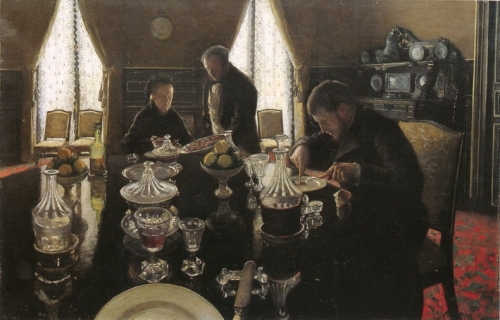
「昼食」
こちらこそ画像と実際の作品を見た時とで立ち位置が全然違って驚いた作品。
実はジャックマール・アンドレ美術館での展覧会に出展されていて、
もう一度みたいと思っているもののひとつです。
この作品の手前にお皿が並んでいるのですが、前に立った時「あ、ここが自分の席なんだ、これからここに自分は座るんだ」と思いました。そしてその割にはなんだか暗い室内と会話のない家族の食卓。
不思議な感覚に襲われます。
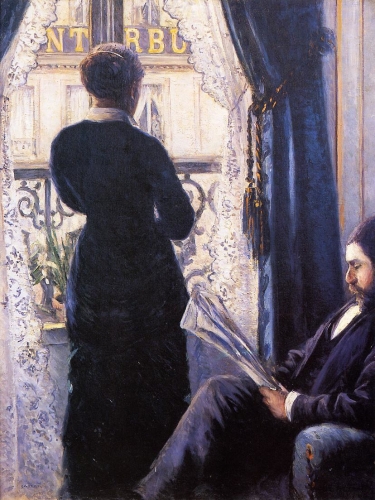
「室内、窓辺の女性」
こちらも同様にジャックマール・アンドレ美術館に出展されていました。
とても印象深かったので、もう一度見てみたい!!
目の前に立ちはだかる女性の圧倒的無言の背中!
物憂げで凜としていて、不満があり決意がある。(気がする)
日本語版の解説にどんな事が書いてあるのかも読んでみたいです。

「マダムXの肖像」
青と黄色で描かれたパステル画を一点。
できれば 「R氏の肖像(男の肖像)」と並んで展示されていたらなお嬉しい。
「R氏の肖像(男の肖像)」と並んで展示されていたらなお嬉しい。
このこの青白い吸血鬼みたいな男性の肖像画を画中画に載せるくらいカイユボットが気に入っていたのか、はたまたR氏とマダムXが夫婦か何かだったのか。
何故この摩訶不思議な色合いで描いたのか。
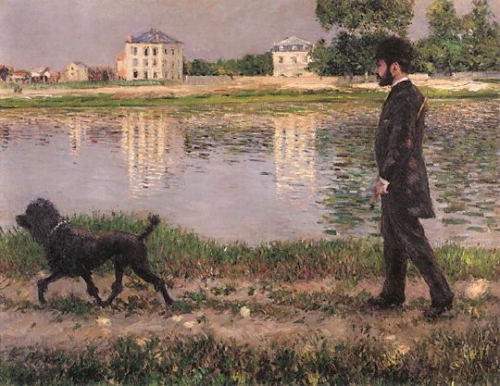
「プティ=ジャンヌヴィリエのリチャード=ガロとディック」
わんちゃんがいつも楽しそうだなぁ〜って。
この絵を見たらきっと楽しい気分になれると思います。
「ヨーロッパ橋」もそうですが、犬に連れられて作品の中を巡れるなんてきっとワンダフル。
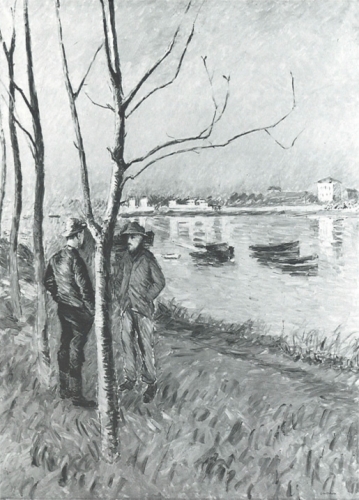
「プティ=ジャンヌヴィリエの岸辺、冬」
白黒の画像しか見たことのない作品はなかなかランクインしませんでしたが、
こちらはカイユボット最後の自画像ということで、一度見てみたいと思っています。
どんな色合いで、どんなタッチなのかしら。そしてどんな気持ちで描いたのかしら。
他にも図録で白黒しか見たことのない作品が来ていたら嬉しいな!
あと、食べ物&食材シリーズも見てみたいな!
それからこうしたサムネイルでは全然気がつかないけれども、実際に見てみたら新しい発見が色々あるような良い作品が来ていたらいいな!
ようするにとても期待しています(*゚ω`人)
そしてこちらはブリヂストン美術館さん所蔵の作品となりましたので当然出展されているでしょうが、
これを機会に研究発表などあれば嬉しいですね。
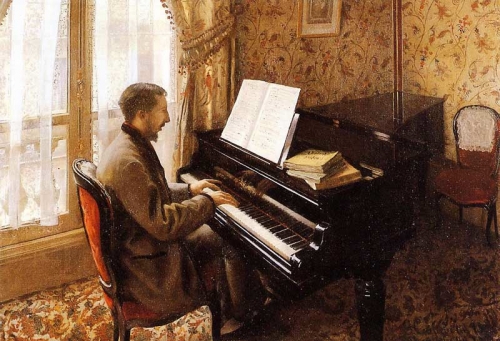
「ピアノを弾く若い男」
